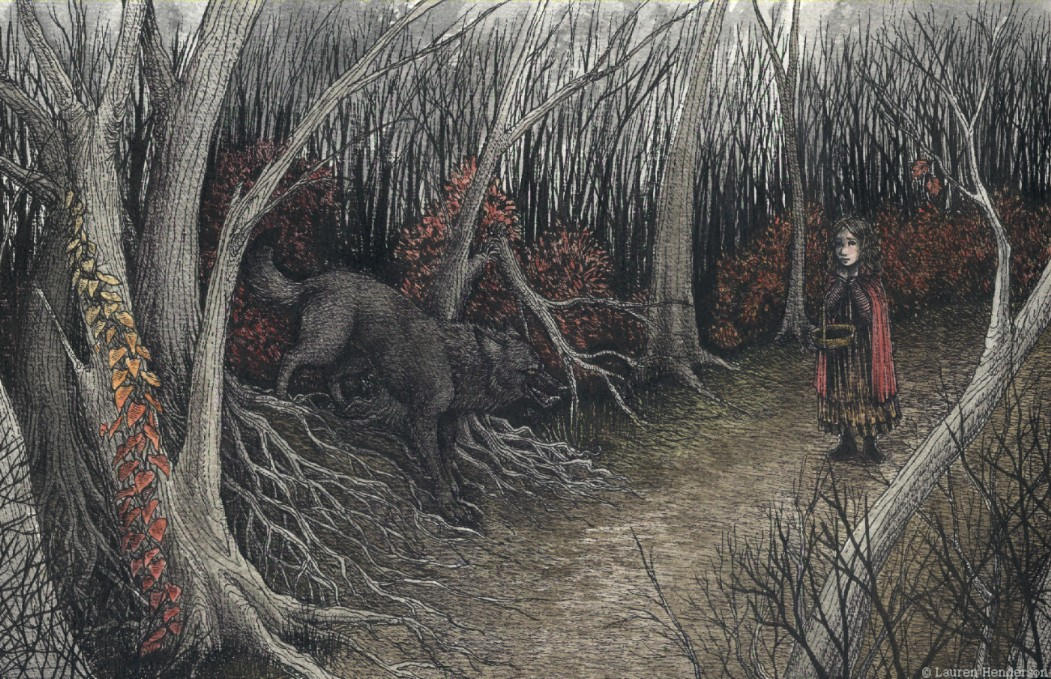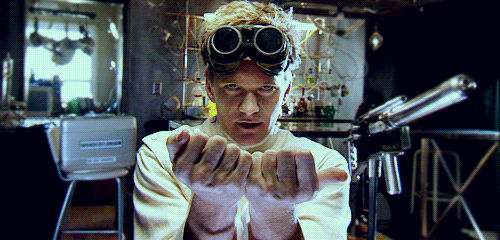The previous post covered the fairy tale that most obviously fits the structure of Guillermo del Toro's 2006 Spanish film Pan's Labyrinth. Charles Perrault's Le Petit Chaperon Rouge, better known as Little Red Riding Hood, contains certain aspects that coincide with Ofelia's journey through the labyrinth—especially the 'little girl lost' motif. I already did some analysis here, but I think it would much more interesting to see how the film transforms not only the Red Riding Hood myth, but fairy tales in general. del Toro uses an amalgamation of folkloric stories—and even creates a few of his own—so it would be truly unfair to limit the film to just one. Click that last link for the previous post where I noted similar visual/imagery styles between P'sL and LRRH, and read through this post for in-depth ties to the fairy tale genre (or, for Mimi, the continuation of part two and inclusion of part three on the criteria sheet).
 |
| Rated R for graphic violence and some language. |
The fairy tales in Pan's Labyrinth act as a form of escapism for both the character Ofelia and the audience. While del Toro does an excellent job creating a fresh story within a narrative text and mythical subtext, the film was only as successful as it was because he adhered to basic fairy-tale tropes with which we are all familiar, at some level. The rule of three in literature is probably the most important. This can be very basic, as with a beginning, middle, and end to a story, a three act structure in screenwriting like the other two movies in this 'trilogy' (The Devil's Backbone and The Orphanage), or through canonical layering, i.e., del Toro's civil war, fairy tale, and coming-of-age stories. Or, it could have more blatant symbolism attached. In fairy tales, there are usually three daughters/sisters (Cinderella) and three brothers or princes; there were three little pigs with three houses; Goldilocks met three bears; Rumpelstiltskin spins golden thread three times for the girl that can guess his name over three days; wishes granted by djinn come in threes; Snow White is visited by her wicked stepmother—you guessed it—three times; the list goes on for ages. This number hails back to texts from a plethora of religions, such as Christianity's holy trinity in the Bible, Odin's three earthly hardships or Ragnarök with a precedent of three harsh winters in Norse mythology, the Triple Bodhi of Buddhism, Trimurti in Hinduism, triple deities in Celtic Paganism, e tcetera. Don't even get me started on triplets in Greek myth .
So, yes, threes are extremely important. It usually depends on the tale to understand just what they symbolize. In Red Riding Hood, things that repeat three times act as warnings, such as the wolf's hunger brought on by three days of starvation. In Pan's Labyrinth, Ofelia's three tasks mark phases in her departure from childhood while the three storehouse keys signify both salvation in the form of medicine and destruction in the form of an unbroken lock. The gigantic toad is killed with three magic stones, the Underground Palace possesses three thrones, the faun supplies three faeries, and Ofelia must choose from three doors once inside the Pale Man's domain. I have typed the word 'three' far too many times, and I hate grammatical repetition. However, I still need to mention that adults saw Ofelia's magic as 'real' three times: Carmen and the mandrake's fiery death, Mercedes' observation of the chalk door in Ofelia's bedroom, and the Captain's inability to bear witness to Ofalia's interaction with the faun at the center of the labyrinth. But Rachel, you said that they saw the magic, yet the Captain clearly did not! I attribute this not only the film's commentary on Ofelia's coping mechanism, but the Captain's complete failure to perceive beauty; that kind of thing strays too far from a regimented world such as his.
Twos are also significant, since that the doctor doses Carmen with two drops of laudanum, the mandrake needs two drops of blood, the Pale man possesses two eyeballs, Ofelia eats two grapes, and so on. Twos are more representative of duality, which makes sense in this film given that it consists of two intermingling worlds.
So, yes, threes are extremely important. It usually depends on the tale to understand just what they symbolize. In Red Riding Hood, things that repeat three times act as warnings, such as the wolf's hunger brought on by three days of starvation. In Pan's Labyrinth, Ofelia's three tasks mark phases in her departure from childhood while the three storehouse keys signify both salvation in the form of medicine and destruction in the form of an unbroken lock. The gigantic toad is killed with three magic stones, the Underground Palace possesses three thrones, the faun supplies three faeries, and Ofelia must choose from three doors once inside the Pale Man's domain. I have typed the word 'three' far too many times, and I hate grammatical repetition. However, I still need to mention that adults saw Ofelia's magic as 'real' three times: Carmen and the mandrake's fiery death, Mercedes' observation of the chalk door in Ofelia's bedroom, and the Captain's inability to bear witness to Ofalia's interaction with the faun at the center of the labyrinth. But Rachel, you said that they saw the magic, yet the Captain clearly did not! I attribute this not only the film's commentary on Ofelia's coping mechanism, but the Captain's complete failure to perceive beauty; that kind of thing strays too far from a regimented world such as his.
Twos are also significant, since that the doctor doses Carmen with two drops of laudanum, the mandrake needs two drops of blood, the Pale man possesses two eyeballs, Ofelia eats two grapes, and so on. Twos are more representative of duality, which makes sense in this film given that it consists of two intermingling worlds.
 |
| Three Doors and an Athame—sounds like a game-show title, no? 'Come on doooown!' |
Music is incredibly important in this film. The myth of Princess Moanna (see the next section) has its own theme, recognizable as Mercede's lullaby and later identified as Ofelia's leitmotif. Listen to Javier Navarrete's orchestration below. It certainly shivers my timbers.
Pan's Labyrinth Lullaby—Nana del fauno del laberinto.
On top of these thematic and symbolic choices, del Toto integrates a slew of mythical creatures from belief systems around the world. 'Faun' is an Ancient Greek term for a satyr-like being in Roman mythology. They are half-man/half-goat and play on the gullible nature of humans in order to get what they desire. It is unclear if the faun in the film—named Pan like the Greek god of the wild—is trustworthy or simply trying to get back to the Underground Kingdom before he dies out like the rest of his kind, but it makes me feel better on a personal level to think that he had to test Ofelia's true spirit by doing a kind of double-cross with the final trial. He does show up in the royal court, after all. On top of the faun we have his three helpful faeries, one of which transformed from a giant stick bug into a 'more appropriate form'. The giant toad and the Pale Man are both monsters that Ofelia needed to defeat, and it could be easily argued that the Captain as an evil stepfather is a monster, too. In fact...though human, he is without a doubt the most monstrous being of the story.The film actually has its own original fairy tale: "Princess Moanna, whose father is the king of the Underworld, becomes curious about the world above: the human world. When she goes to the surface, the sunlight blinds her and erases her memory. She becomes very ill and eventually dies. However, the king believes that her spirit will come back to the Underworld someday." And so they waited for her...for a very long time.
The story Ofelia tells to her unborn brother about the blue rose of immortality is similar to that of Sleeping Beauty, what with the thorns acting as an unbreachable barrier. It also connects to the idea of virginity/purity present in most fairy tales. The faun wanting the Princess to prove her purity; the overall shape of the Moribund Tree, which Ofelia enters and leaves like a womb; the bleeding book of precognition; Carmen's pregnancy; Ofelia's eventual maturity. In Sleeping Beauty, the princess only awakes because the Prince has had sexual intercourse with her and she needs to give birth. Both princesses in Snow White and The Juniper Tree have 'lips red as blood, skin white as snow'—a glaring symbol of menstruation or a broken hymen. Little Red Riding Hood features not only the coloured headpiece but the girls' own innocence. The Littlest Mermaid is all about reaching a certain age and acquiring love. I could go on and on in this direction.
Pan's Labyrinth gives me the perfect excuse to talk about another Labyrinth. Jim Henson's 1986 film focuses on a the adolescent Sarah and her fairy-tale journey. She deals with an evil stepmother of her own, as well as trials and monsters galore. Ofelia did not have to face a singing, dancing goblin king with outrageous hair, but I'd chose to fight '80s glam David Bowie any day over the three-times-almost-but-not-quite-killed torturing bastard who is the Captain in Pan's Labyrinth. Yikes.
 |
| Ofelia with the faun's book, Sarah with hers. The covers are even the same exact colour, for Crispin's sake! |
Why did Guillermo del Toro chose to tell this story through the use of myth? Supernatural elements tend to be well-contrasted with grim realities, and the Spanish Civil War of 1944 fills that bill to a T. Myths were created by human beings in the first place in order to rationalize unexplainable concepts like death and cruelty. Ofelia used her imagination to cope with her mother's illness brought on by pregnancy, having to leave the city because of her father's death, and the sins of her new stepfather. Paralleling those things with surrealistic characters and ineffable trials was a good move on the director's part. It helped the audience to deal with scenes of torture when they were then also faced with the acts of a non-human cannibal. I know that sounds bizarre...but it's true.
A final note: I see a trend in fairy tale movies of casting dead relatives in fantastical roles. In the film MirrorMask, the main character Helena's mother, Joanne, is sick, so when Helena travels to the other side her mother becomes the Queen of Light and Queen of Dark, emphasizing the way her moody teenage daughter views her in real life. In The Brother's Grimm, Angelika's father, the huntsman, is turned into the wolf by the evil Queen, dying once he is no longer under her spell. Van Helsing sees Anna's brother, Velkan, shed his human form and turn into a werewolf. The list goes on. This transformation allows the main character to deal with the loss, just as Ofelia did with her own mother.









